Africa
Note: this is the third post in a series about my trip to India and Africa. The others are available at Amsterdam and India. The full set of pictures is also available on Flickr.
We flew from Mumbai to Tanzania on Kenya Airways. We had a long 11 hour layover in Nairobi, but we were warned not to leave the airport or else we would likely be mugged or robbed. We stayed inside.
 The first event was a big one: climb Mount Kilimanjaro. We had a great group of people to climb with - 3 Americans and two Germans.
The first event was a big one: climb Mount Kilimanjaro. We had a great group of people to climb with - 3 Americans and two Germans.
 The climb started off in the rainforest jungle. It rained nearly every day, so we had to learn how to deal with the downpour. Ziplock bags to the rescue!
The climb started off in the rainforest jungle. It rained nearly every day, so we had to learn how to deal with the downpour. Ziplock bags to the rescue!
 The entire climb took 7 days: 5 up and 2 down. We climbed slowly in order to acclimatize to the 19,000 foot altitude. Some campsites had magnificent views. Some did not.
The entire climb took 7 days: 5 up and 2 down. We climbed slowly in order to acclimatize to the 19,000 foot altitude. Some campsites had magnificent views. Some did not.
 A team of 26 porters, guides and chefs carried all the gear for us, including delicious meals, dining gear, and a "toilet tent."
A team of 26 porters, guides and chefs carried all the gear for us, including delicious meals, dining gear, and a "toilet tent."
 On the final day, a freak snowstorm covered the peak of the mountain in snow and clouds, freezing everyone to the bone. My glasses froze over.
On the final day, a freak snowstorm covered the peak of the mountain in snow and clouds, freezing everyone to the bone. My glasses froze over.
 Despite the cold we successfully made it to the top! Unfortunately we couldn't see anything at all. Supposedly it's one of the most magnificent views of the African plains that can be seen. 😐
Despite the cold we successfully made it to the top! Unfortunately we couldn't see anything at all. Supposedly it's one of the most magnificent views of the African plains that can be seen. 😐
 After seven days on the mountain living in tents without showers, we were excited to get back to the hotel.
After seven days on the mountain living in tents without showers, we were excited to get back to the hotel.
 After the climb, we went on a safari in the Serengeti National Park. The scenery was unbelievably amazing - we saw hundreds of thousands of animals.
After the climb, we went on a safari in the Serengeti National Park. The scenery was unbelievably amazing - we saw hundreds of thousands of animals.
 Lions sat by the side of the road and weren't even bothered by all the tourists snapping pictures of them.
Lions sat by the side of the road and weren't even bothered by all the tourists snapping pictures of them.
 Due to excessive rainfall, we got a free upgrade from tents to these "luxury lodges".
Due to excessive rainfall, we got a free upgrade from tents to these "luxury lodges".
 The Ngorongoro Crater is one of the most beautiful places in the world. Stunning.
The Ngorongoro Crater is one of the most beautiful places in the world. Stunning.
 One day we saw a pride of lions eating a giraffe. The next day the giraffe carcass was almost completely gone. Here a hyena and a jackal are scavenging it.
One day we saw a pride of lions eating a giraffe. The next day the giraffe carcass was almost completely gone. Here a hyena and a jackal are scavenging it.
 We were lucky enough to spot a cheetah and 3 of her cubs eating a gazelle.
We were lucky enough to spot a cheetah and 3 of her cubs eating a gazelle.
 Apparently leopards are even rarer, but we saw one of those too.
Apparently leopards are even rarer, but we saw one of those too.
 There were so many giraffes that we had to shoo them out of the road.
There were so many giraffes that we had to shoo them out of the road.
 Warthogs are actually fairly ugly. The Lion King was a lie.
Warthogs are actually fairly ugly. The Lion King was a lie.
 Herds of wildebeest were all over the place.
Herds of wildebeest were all over the place.
 Rhinos are very endangered - there were only 21 of them left in this area.
Rhinos are very endangered - there were only 21 of them left in this area.
 When we forded this river I was sure we would get stuck.
When we forded this river I was sure we would get stuck.
There are a lot more pictures, but I don't have room to include them all here. Head over to the Flickr set for more!
India
Note: this is the second post in a series about my trip to India and Africa. The others are available at Amsterdam and Africa. The full set of pictures is also available on Flickr.
After Amsterdam, we flew off to India.
 The first stop was New Delhi, the capital. The city is very much under construction and extremely polluted, much like Beijing. I had heard that cows idly wander the streets with no fear or harassment in India, but I was surprised at the extent to which this is true. Cows were everywhere.
The first stop was New Delhi, the capital. The city is very much under construction and extremely polluted, much like Beijing. I had heard that cows idly wander the streets with no fear or harassment in India, but I was surprised at the extent to which this is true. Cows were everywhere.
 This is the India Gate - an arch built by the British commemorating WWI.
This is the India Gate - an arch built by the British commemorating WWI.
 Qutb Minar - built by the Mughals.
Qutb Minar - built by the Mughals.
 Big dosa. The Indian food was very good all around. It was sometimes difficult to tell which food was safe to eat (cooked and/or boiled) if you were not familiar with what each dish was made of.
Big dosa. The Indian food was very good all around. It was sometimes difficult to tell which food was safe to eat (cooked and/or boiled) if you were not familiar with what each dish was made of.
 The Taj Mahal is in Agra, a city about 400 km outside of Delhi. It was rainy and polluted on the day we went.
The Taj Mahal is in Agra, a city about 400 km outside of Delhi. It was rainy and polluted on the day we went.
 The Red Fort of Agra is another attraction in the city.
The Red Fort of Agra is another attraction in the city.
 In the opposite direction is Jaipur, the capital of Rajasthan, famous kingdom of the Maharajahs.
In the opposite direction is Jaipur, the capital of Rajasthan, famous kingdom of the Maharajahs.
 The Water Palace is a famous attraction.
The Water Palace is a famous attraction.
 Elephant rides were available for a fee.
Elephant rides were available for a fee.
 Snake charmers huddled around touristy areas.
Snake charmers huddled around touristy areas.
 Next up was Jamshedpur, a smaller mining town on the eastern side of the country. We attended the wedding of a friend. It was a traditional-style Sikh wedding.
Next up was Jamshedpur, a smaller mining town on the eastern side of the country. We attended the wedding of a friend. It was a traditional-style Sikh wedding.
 The groom rides a horse to the ceremony.
The groom rides a horse to the ceremony.
 Everyone wanted a picture with the funny white people.
Everyone wanted a picture with the funny white people.
 Kolkata (Calcutta) is another major city nearby, on the shores of the holy Ganges river. People famously come from far away to "wash" in what must be the filthiest river in the world.
Kolkata (Calcutta) is another major city nearby, on the shores of the holy Ganges river. People famously come from far away to "wash" in what must be the filthiest river in the world.
 Many flowers are available for purchase to use as offerings to the gods.
Many flowers are available for purchase to use as offerings to the gods.
 Mother Teresa's house for the sick and dying is next door to the Temple of Kali, Goddess of Destruction. It was sort of a weird juxtaposition.
Mother Teresa's house for the sick and dying is next door to the Temple of Kali, Goddess of Destruction. It was sort of a weird juxtaposition.
 Mumbai was the last stop on the trip. This hotel is the site of the 2008 terrorist attacks. It seems to have recovered fairly well, though security was very high.
Mumbai was the last stop on the trip. This hotel is the site of the 2008 terrorist attacks. It seems to have recovered fairly well, though security was very high.
 Mumbai has a very nice waterfront and is the most clean and modern ("Western"?) of any Indian city we visited. Unfortunately we were laid low by an E-Coli infection while in Mumbai and didn't get to see much of the city.
Mumbai has a very nice waterfront and is the most clean and modern ("Western"?) of any Indian city we visited. Unfortunately we were laid low by an E-Coli infection while in Mumbai and didn't get to see much of the city.
Fortunately we recovered just in time for the next leg of the trip - Africa!
Amsterdam
In December after leaving my job at Microsoft, I went on a trip to India and Africa for a month. I'm only now getting around to writing up a post about it since I've been super-busy recovering from the trip, moving to San Francisco, and starting my new job at Facebook (more about that later).
The full set of photos is up on Flickr for perusal now. This is the first post in a series about the trip - the others are available at India and Africa.
 On the way to India we stopped in Amsterdam for a day. It was the middle of winter, so many things were closed, including the famous Rijksmuseum, above. Had it been open, I would have apparently been able to see lots of Rembrandts, Vermeers, Van Goghs, etc..
On the way to India we stopped in Amsterdam for a day. It was the middle of winter, so many things were closed, including the famous Rijksmuseum, above. Had it been open, I would have apparently been able to see lots of Rembrandts, Vermeers, Van Goghs, etc..
 Here are some of the famous "fries with mayonnaise."
Here are some of the famous "fries with mayonnaise."
 The city's canal system is very extensive - it's nicknamed the "Venice of the north". The only boats I saw anywhere were tourist boats, so the canals don't seem to get much real use any more.
The city's canal system is very extensive - it's nicknamed the "Venice of the north". The only boats I saw anywhere were tourist boats, so the canals don't seem to get much real use any more.
 We went on a tour of the red light district called "Randy Roy's Redlight Tour". It's run by an American woman from Michigan(?). It was very informative - recommended.
We went on a tour of the red light district called "Randy Roy's Redlight Tour". It's run by an American woman from Michigan(?). It was very informative - recommended.
 This is the main train station, which provides easy access to/from the airport.
This is the main train station, which provides easy access to/from the airport.
 A big attraction is the Heineken brewery and museum "experience". Unfortunately we only had one day so I didn't have time to go inside.
A big attraction is the Heineken brewery and museum "experience". Unfortunately we only had one day so I didn't have time to go inside.
Next up: India!
Managing photos with iPhoto + Flickr
This weekend I worked on setting up an organizational system for my digital photographs. Up until this point I've just been dumping pictures into folders, roughly organized by trips and dates. There were several problems with this system: there was no easy way to find pictures of specific people, it was difficult to browse through just the good photos, and they weren't automatically shared with anyone unless I manually uploaded them somewhere myself. It required too much work to upload and share photos that I often never got around to it.
I needed to find a system which would keep the photos organized and automatically share them on an internet site like Flickr for me. I looked at a lot of different photo apps and Flickr clients, and ultimately decided to use iPhoto. Its Flickr compatibility has some limitations, but it goes far beyond any other system in terms of ease of use. Here's how my setup works:
After a trip or a day of taking photos, plug in the camera to the computer. iPhoto pops up and offers to download all the pictures and automatically sort them into "Events". Events are just collections of all the photographs taken over a certain time period. It defaults to splitting by days, but you can also split the events between certain photographs:

This works fairly well for a first level of organization. The events contain every single photo taken, even if you took 10 photos of a certain object in order to get the perfect shot - that's OK. We'll sort out the good photos from the rest when we get to the Album layer later. You can leave all the originals in the events and not have to worry about losing them.
While still working with the events, it's only a few clicks in iPhoto to automatically tag all the photos with the location of the event (if your camera does not have a GPS built-in). A Google Maps window pops up and allows you to search to assign the location ("Tiananmen Square"), or drop a pin on the exact coordinates. All the photos in the event are then automatically tagged with the GPS coordinates and the name of the location.
The next step is where iPhoto really shines. The "Faces" feature scans all your photos and automatically finds people's faces in the photos. If it doesn't know who a certain person is, it prompts you to assign a name to the face. Once you assign a certain person's face in a couple of pictures, it automatically recognizes that person in the other photos. Then you just need to click "Confirm" or "Reject" on all of the other suggested faces to commit them. This will automatically tag all the photos with the names of the people in them. Overall I find that this feature works surprisingly well - you'll never want to go back to manually tagging people in photos again. Here are a few pictures of me that it automatically detected:

Next I like to pull out just the good photos, for browsing and sharing on Flickr. iPhoto has "Albums" for this, and you just need to select the good photos from an event and drag them in. One album can contain photos from multiple events, or not: how you want to organize things at this level is up to you. Unfortunately there's no hierarchy between Albums. I would have liked to create a super album called "China Trip" which contains sub albums for "Bejing", "Shanghai", etc., but it's not possible to do this. That's probably just as well because most internet photo-sharing sites don't allow nested albums either (Facebook & Flickr being the two big ones).
Once everything is organized into albums, it's only a few clicks to sync all the albums to your Facebook or Flickr account. iPhoto takes care of automatically uploading all of the pictures and syncing the metadata like the location and people tags. There's very little flexibility at this point - iPhoto will sync everything in the albums without giving you many options to control the details of what gets uploaded (for example, if you had kids you might not want to sync the names or photos of the kids). However, if you keep these limitations in mind while making the albums, it works out fine.
And that's it - once you have everything set up, then there's very little "maintenance" work that you have to do with the photos. Just plug the camera in, name the event, accept the detected faces (assuming it's already been trained), and pick out the best photos for an album that automatically gets syncd up to Flickr or Facebook. You don't need to manually tag or upload anything (unless you want photo-specific tags like "street vendor" or something like that, which are significantly easier to tag right in iPhoto than on the web).
I've done all this with my recent photos and syncd them to my Flickr account, if you want to check out the results: http://www.flickr.com/photos/efaller/
Furthermore, if you use WordPress for your blog, it's easy to install a Flickr plugin which creates a new "Insert Flickr Photo" button, which makes it super-easy to insert your photos into a blog post. You just click the one you want, and it automatically chooses a thumbnail of appropriate size, inserts it, and links it to the full-res version on Flickr. No need to mess with manually resizing the photo and using the WordPress upload screen any more. Here's an example:
The plugin linked above also includes a handy sidebar widget that automatically displays a random selection of your photos, linked to Flickr:
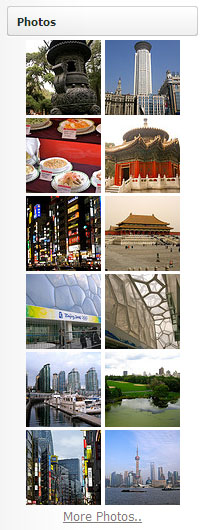
All this without needing to manually upload anything! I expect that I'll be able to keep up with this system since it's so easy. There's no more excuse not to get all my good photos uploaded with the appropriate tags.
Tokyo
This is the sixth part in a series - for the others see Beijing Day 1, 2, 3, 4-5, or Shanghai.
Our plane from Shanghai to Tokyo arrived at around 4 PM. The trip from the airport to the hotel was a good example of at least one difference between China and Japan: prices and labor costs are much higher. We caught a train for $35 - a taxi would have been prohibitively expensive. In China (and most of the third world), labor is plentiful and therefore cheap, while manufactured goods are (comparatively) expensive, so it's usually cheaper and easier to just pay somebody to do something. In Japan (and the first world), labor is expensive and goods are cheap, so any tasks which can be done by an automated process or a machine will usually be done that way. In Tokyo the most visible manifestation of this was the vending machines which were everywhere - there are vending machines to sell drinks (both hot & cold), cigarettes, toys, train tickets, and even to take your order in some restaurants. In China all of these tasks would be performed by people (or just as often, several people).
Our hotel was located in Shinjuku, which is one of Tokyo's many districts. It's big on shopping & business, with lots of stores and restaurants. After settling into the hotel we explored around outside a little bit:
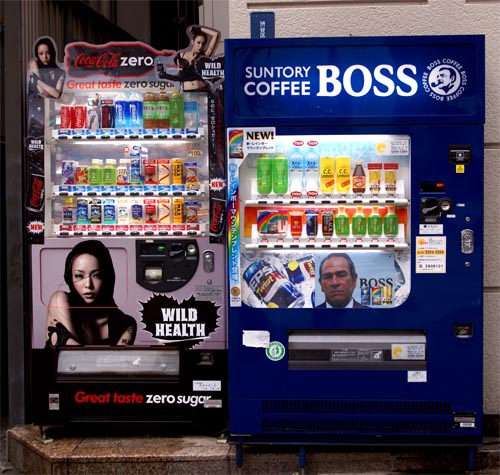
Vending machines selling all kinds of drinks are everywhere
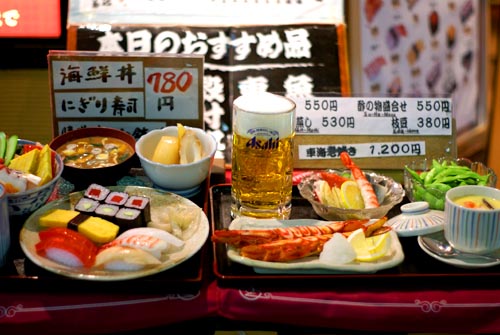
Most restaurants have displays outside the entrance with plastic versions of the food on the menu. This restaurant has plastic sushi, plastic soup, plastic vegetables, and a plastic mug of beer.
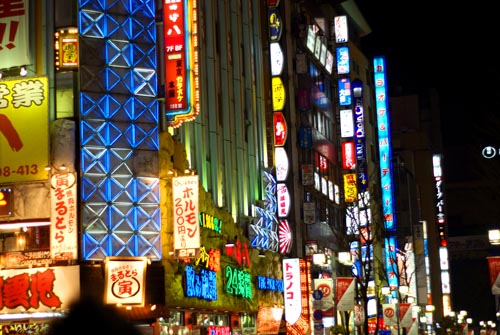
Real estate is at a premium, so things are built vertically. Any given building might have 8 floors of different businesses - effectively becoming its own mini-mall. The neon signs going up the building each advertise the shop or restaurant on the corresponding floor.
The next morning we went up to the top of the Tokyo Metropolitan Government building, one of the taller skyscrapers in the area. The view was impressive - the city stretched on in all directions as far as the eye could see, which unfortunately wasn't too far since it was overcast that day:
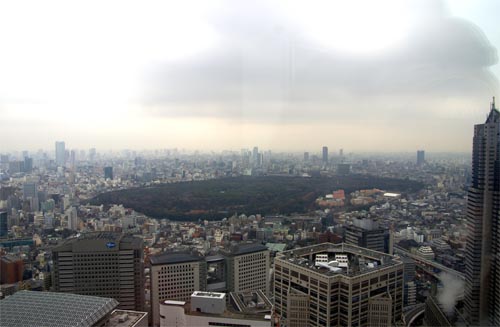
Supposedly Mount Fuji is visible on the horizon on clear days. The large park in the picture above contains the famous Meiji Shrine, which I visited later on. Unfortunately the original shrine was destroyed by American firebombing in WWII (like most of Tokyo), though while I was there I was able to get a glimpse of some cherry-blossoms:

Apparently the cherry-blossoms are much more plentiful and impressive in early April, so we missed them by a couple of weeks.
After Shinjuku was Shibuya, another big shopping district, but with more emphasis on fashion. The train station has a popular statue of the famous dog Hachiko:
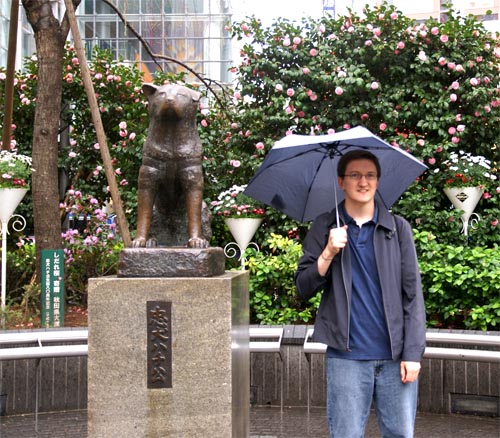
According to legend, he would meet his owner at the train station every day. One day the owner died while at work, but Hachiko faithfully went to wait at the station every day until his own death 10 years later.
Shibuya also has a large pedestrian crossing, supposedly the busiest in the world:
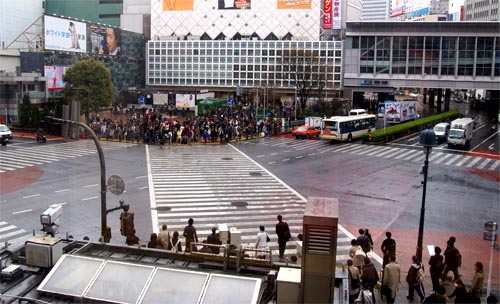
People amass on the sidewalks..
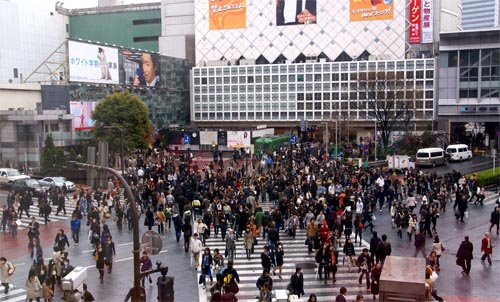
..until it's time to cross
The above two pictures show another big difference from China - there's nobody jaywalking, and the cars are stopping for the people. Street traffic is very orderly and predictable in Tokyo, which I much preferred to the chaos of the streets of Beijing. People seem to take rules much more seriously in Japan - almost as if it is a point of pride. I felt a little more at home when walking around, though it did take a while to get used to the cars driving on the left - people were even rigorous about walking on the left side of hallways or sidewalks.
On the next day I saw the sights in the central downtown district. The first stop was the famous Tsukiji fish market, which sold every kind of seafood you can imagine:
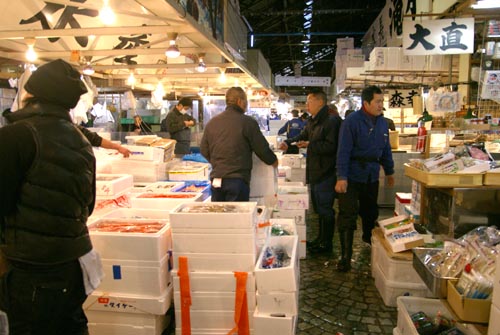

I didn't get up in time to see the big tuna auctions at 5 AM, but apparently they are impressive as well.
Next up was Ginza and the Imperial Palace. Unlike the Forbidden City in Beijing, the palace in Tokyo is closed to the public since the Emperor still lives there. You can walk around outside and get glimpses over the walls and moat:

The imperial palace takes up a large swath of the city - it's large enough that in the bubble of the 80's, Tokyo land prices implied that the palace was worth more than all the land in California. Needless to say, that bubble eventually popped, leading to a 20-year recession from which the real estate and stock markets still haven't recovered (hmm..).
After that was Akihabara, which is the "nerd Mecca" of the world: an entire city district devoted to video games, electronics, computers, manga, etc. This is the place where things like the Humping USB Dog are born (.. yes.. I bought one - but it was for a friend.. yeah.). The electronics stores were humongous - imagine a Best Buy, and then imagine it being 7 floors tall, stocked to the brim with all the gear you could ever want. One store had two long aisles devoted completely to USB hubs (Hello Kitty hubs, Star Wars hubs, etc.). I kept seeing rows of tiny Japanese laptops, and I eventually broke down and bought one (it had been getting pretty annoying browsing the web on my iPhone, so I was in need of a travel netbook, or at least that's how I rationalized it):
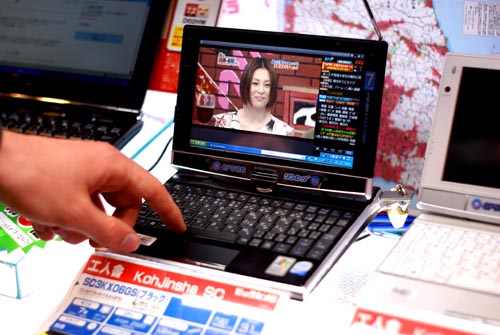
The laptop has a 7 inch 1024x600 screen (same rez as a 10" netbook), a 1.33 GHz Intel Atom w/ hyperthreading, a GPS, touch screen, webcam, swivel tablet screen w/pen, TV tuner, SD/CF card readers, an ExpressCard slot, and 1 GB of RAM (because of Microsoft's restrictions for selling XP - I've already ordered an upgrade). The keyboard is in Japanese, but fortunately also has the roman letters. All that for only 39,000 Yen, or about $390 (duty free - no tax!). So far I'm pleased with it, but ironically it's almost too small - it's hard to type on such a tiny keyboard.
On our last day in the city we had exhausted our list of things to do (again, mostly because we had failed to properly research ahead of time), so we did the most pathetic thing possible and went to Tokyo Disney. It's in the bay outside the city on a large plot of 'reclaimed' land. They have built a near-exact replica of the Disneyland in California - it's sort of surreal. On the other hand it sort of felt right - the dual crazinesses of Disney and Japanese culture were practically made for each other. Fortunately we finally had a sunny day:

Tokyo Disney was bearable and even fun, provided that you maintained a certain ironic detachment (or a childlike naivete and curiosity). One of the resorts is "DisneySea," which is unique to Tokyo and has a maritime theme:

At one point it got almost a little too weird when we ate lunch in the little "fake America" town and had NY deli sandwiches. One thing which did not work was the tendency for immense lines to form at each ride. I waited two hours for one ride and then decided that that was enough waiting in line for the day. At one point the line for the Indiana Jones ride was four hours long. I'm not sure that would happen even at Disney World in Florida at peak season. I could only surmise that Japanese people are much more patient and willing to wait in lines than Americans are.
On the last day our flight to Seattle left at 3:40 PM, so we didn't have time to do much other than check out and take the train back to the airport. The flight was 8 hours, and arrived at 8 AM, technically on the same date. Going 16 hours back in time made it a little hard to get back on a normal sleep schedule, but with a strategically timed nap on the first day back (and some Tylenol PMs for a couple nights..), I was able to get back to normal pretty quickly.
Shanghai
This is part 5 in a series - for the others see Beijing Day 1, Day 2, Day 3, or Days 4-5.
We arrived in Shanghai via train at 7:30 in the morning. We weren't quite sure what to do with our bags at that point so we just took a cab to our hotel, hoping that they would allow us to store them until check-in time. Luckily, they had the room already available and we were able to check in at 8:00 AM. There didn't even seem to be any surcharge or fee.
The hotel was pretty centrally located in downtown Shanghai, so we were able to walk out and see pretty good views of the Huangpu riverside:
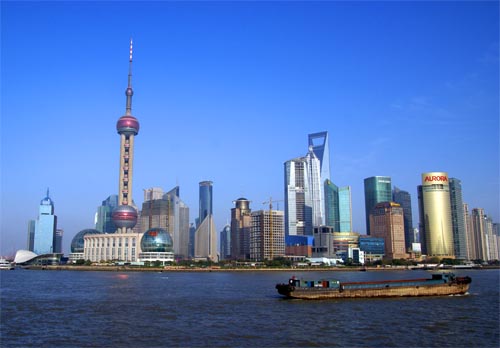
On the east side of the river is Pudong, which is the ultra-modern business/financial district of the city. Most of it has been constructed within the last 15 years. On the west side is "The Bund", which is the old part of the city:
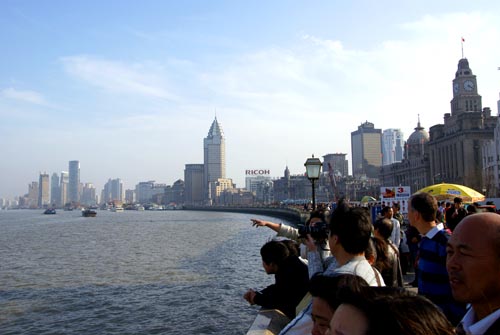
Many of the buildings along the waterfront here were built in the British/French colonial days of the 19th Century. This gives Shanghai a weird sort of architectural vibe - it's split between the new and the old, yet neither is traditionally "Chinese" in character.
The city has a distinctly different feel than Beijing. It's very Westernized and there's relatively little in the way of Chinese cultural history behind it. Before the Opium Wars, Shanghai was just a small port village at the mouth of the Yangtze River. After the wars it was conceded to the foreign powers, who built it into a big city. Even though it was eventually taken over by the communists, there are still large numbers of foreigners living in the city, often living in their own little isolated enclaves, surrounded by millions of Chinese people.
On the first day we walked around nearby the hotel. The city extends farther than the eye can see, and so does the space-age sort of architecture:

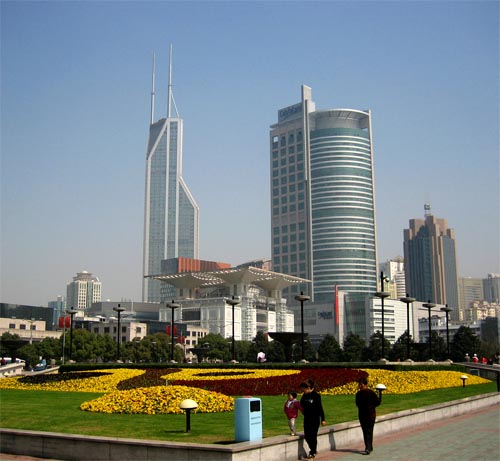
I visited the Shanghai Museum, which is supposedly one of the best in China. It did have a large collection of ancient Chinese artifacts, but the variety of displays was somewhat disappointing (after you've seen a few porcelain bowls, another 200 look pretty similar). It didn't really compare to visiting the Louvre or the Met - I'm not sure whether this was because all of the interesting works of art were plundered by foreigners, or because historical Asian culture just didn't place as much emphasis on venerating the Artist as an individual (I wouldn't be able to name Chinese equivalents of Van Gogh, Michelangelo, etc). Or maybe the true explanation is something my insensitive Western mind is unable to grasp - it was sort of an interesting question to ponder.
On the second day we visited the Yu Gardens, which is a nice little oasis of green in the middle of the city:
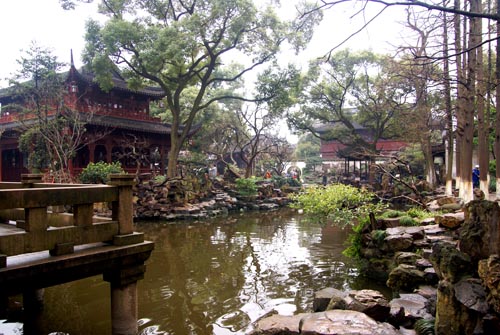
Unfortunately it turned out that the gardens were built for a rich landowner "in the style of" a traditional Chinese garden, so they lost a few authenticity points there. Still, there were some interesting sights, like the Koi pond:

Next to the gardens was a bazaar with all kinds of shops selling various things:
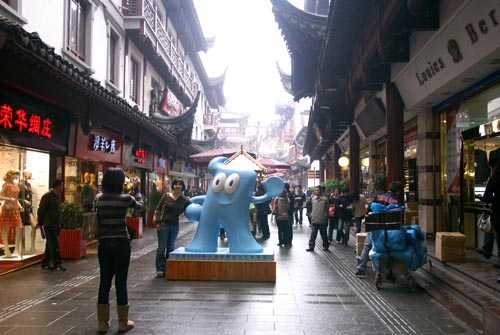
The blue character in the picture above is the mascot for the Shanghai World Expo 2010. He was plastered all over the city, half of which was under (re-)construction in preparation. I imagine that Beijing was similar a couple years ago in preparation for the 2008 Olympics. It's clear that the Chinese government wants the Expo to do for Shanghai what the Olympics did for Beijing - i.e. be a sort of international coming-out party. Even the propaganda boats on the river got in on Expo-fever:
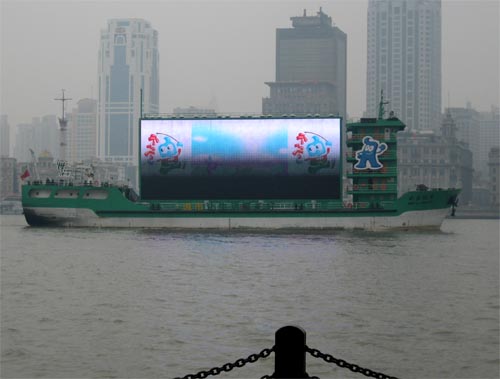
On the third day I went to explore Pudong and the other side of the river. I wanted to visit the Shanghai World Financial Center (the building with the big hole in the top) and see the city from the "tallest observation deck in the world," but unfortunately it was overcast and foggy that day so you couldn't see very far:
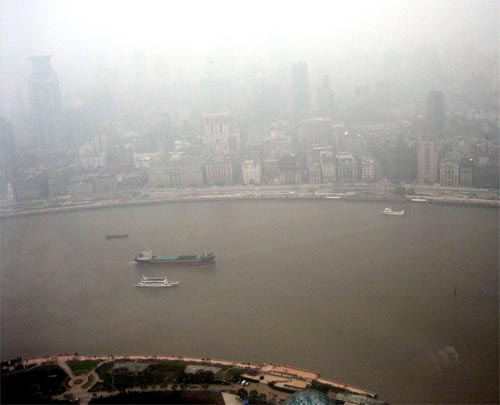
View of the Bund from Pudong
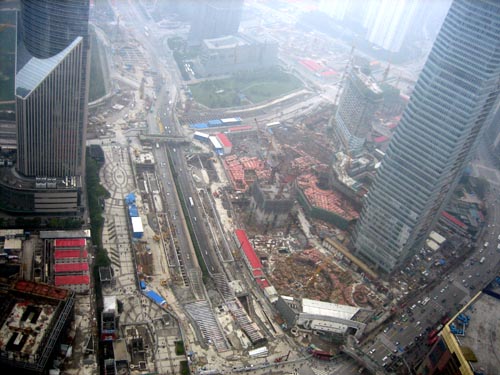
Pudong could be summed up as "under construction"
Other than the skyscrapers, Pudong is mostly a financial & business district, so there wasn't a whole lot else to see.
That evening we went to visit our former co-worker Roland who was in Shanghai working for Microsoft. Unfortunately we only had his address in English, which didn't work too well for the cab drivers. We tried to pronounce the name of the street for one driver, but he got angry and kicked us out of the cab - presumably he was saying "you can't just give me the name of the street, it's very long so I wouldn't know where to stop!" With a second cab, we got the hotel porter to read off the address in Chinese and the driver agreed to try to find it. We finally did make it and our friend took us to a fancy Australian restaurant (yes, we ate Australian food, with our German friend, in China - wait, what?). Unfortunately they were out of ostrich, so he had to settle for an emu steak. We also had crocodile appetizers:
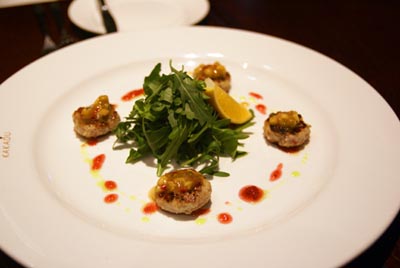
Crocodile sort of tastes like chicken.
On the fourth day in Shanghai we had sort of run out of things to see (more because we failed to fully research ahead of time, rather than because Shanghai did not have enough sites to see). We took the advice of a couple of different people and took a train ride to Hangzhou, a "small" city (only 6 million people!) about an hour and a half away by train. Apparently it's widely revered for its great natural beauty, which probably wouldn't be the first thing you'd say about Shanghai or Beijing. The city's West Lake is the original lake which the Summer Palace in Beijing was modeled after.
Alas, it was also raining and overcast on that day too, but we were able to get a few pictures:

The lake has several islands and pedestrian causeways
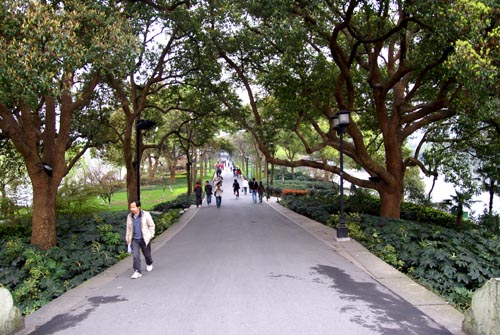

Overall Hangzhou was a nice side trip for the day - it would have been even more so had it not been raining.
On the fifth day we flew off to Tokyo. While in China we had accumulated so much stuff that it wouldn't all fit in our original bags on the flight, so we needed to buy an additional suitcase. We went to the shopping district on Nanjing Road, which is where all the fake knock-off merchandise can be found. Pretty much any piece of expensive designer clothing or apparel can be found as a knock-off in China. There are apparently even several different quality levels of fake goods, ranging from dirt-cheap knock-offs that wouldn't fool even a child, all the way up through really good-looking fakes that would be hard to tell apart from the real things unless you had expert knowledge. For our luggage, we only needed something that functioned, so we picked up this "Samsonmte" suitcase for $14:
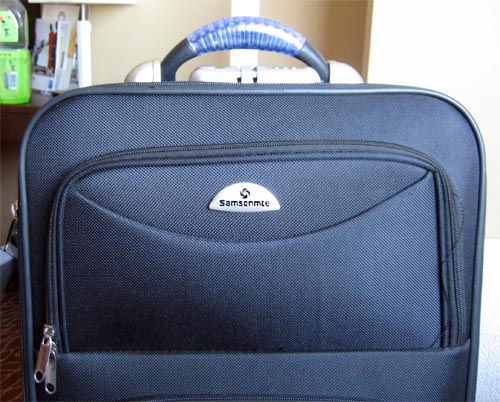
It's the most cheaply-made suitcase I have ever seen - the pockets on the side aren't even real pockets, they just open up into the main compartment. Still, it did the job.
Tomorrow's post: Tokyo!
Beijing Days 4-5
This is part 4 in a series - for the others see Beijing Day 1, Day 2 or Day 3.
On our fourth day in Beijing we went to see the 2008 Olympic Venues. The first stop was the "Water Cube" building where the swim events were held:

The semitransparent blue walls were an interesting sight, though it would probably have been even more impressive to visit at night when they are lit up from within. The ticket to get in was 120 RMB and we had to wait an hour and a half before our timeslot came up. For some reason the tickets were sold on the opposite side of the building from the one entrance - it was rather confusing because most of the English signs in the area were left over from the Olympics and directed you to entrances which are no longer open now that it is a tourist attraction.
The main pool inside the building was fairly impressive:
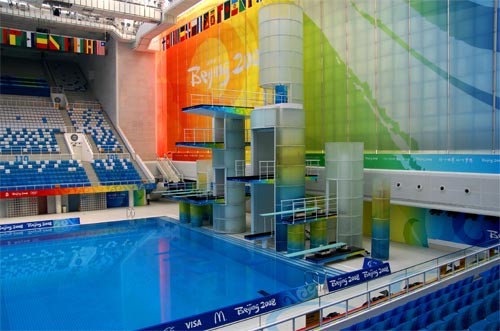
You could only walk around in the stands and take pictures, so there wasn't a whole lot to do. Somewhat surprisingly, it turned out that this was basically the only pool in the building (there was one smaller "warm-up" pool, but it was closed off). Other than the main pool, the only other things to see were a bunch of gift shops hawking 2008 Olympics merchandise.
Next up was the "Bird's Nest" Olympic stadium, for another 120 RMB:
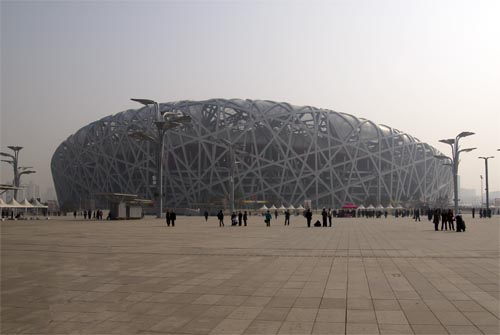
Again the architecture was fairly impressive, but unfortunately the Beijing pollution subdued the sight a little bit. Inside the stadium, only the lowest level of the seats and the field were open to tourists:
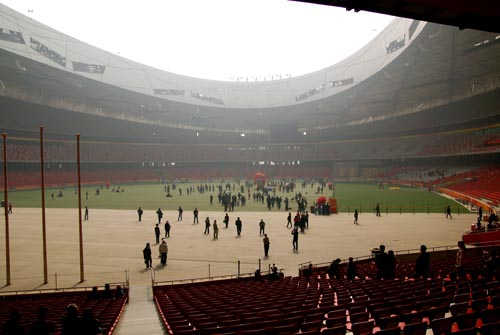
There were some big inflatable "Fuwa" Olympic mascots on the field, but not much else. It turns out that walking around an empty sports stadium is about as boring as you might imagine it to be. I had hoped that there would be some sort of displays or interactive attractions set up for visitors, but there weren't. Overall the Olympic venues were sort of a disappointment.
That afternoon we went to the Temple of Heaven, which is a large Taoist landmark in southern Beijing:
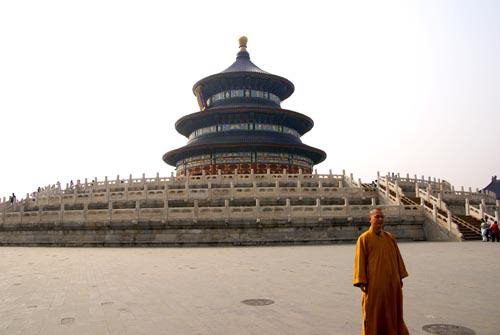
Inside was an altar of some sort, but it was hard to get a good look because of the huge crowd pushing and shoving around the door:
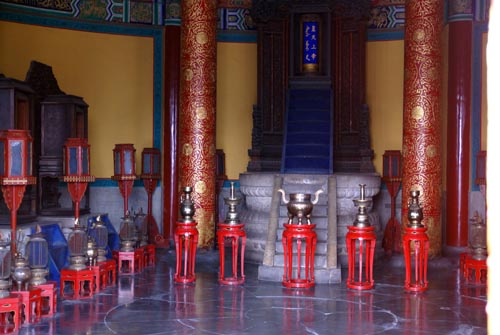
There was a large park around the temple, which seemed to be a recreational area which locals used as a meeting place to get away from the hustle of the city. There were large numbers of people playing cards and other traditional games, as well as people singing and playing musical instruments:

It was an interesting and brief glimpse into a more traditional part of Chinese culture, which is sort of rare in the big cities.
On Day 5 we had a ticket to leave for Shanghai in the evening, so we just went to the Beijing Zoo in the morning. The zoo is famous for its panda bears, and we weren't disappointed:
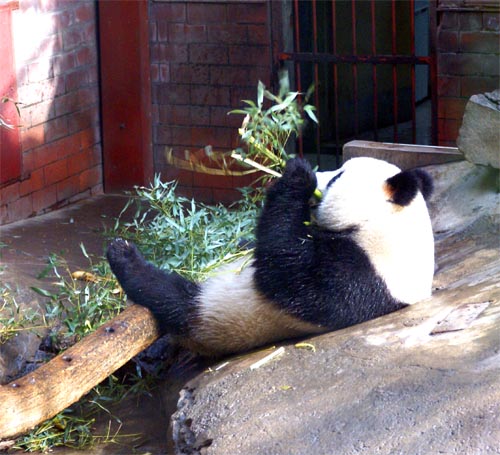
Chewing Panda
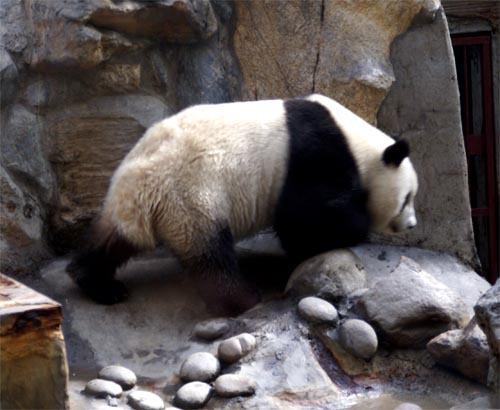
Walking Panda
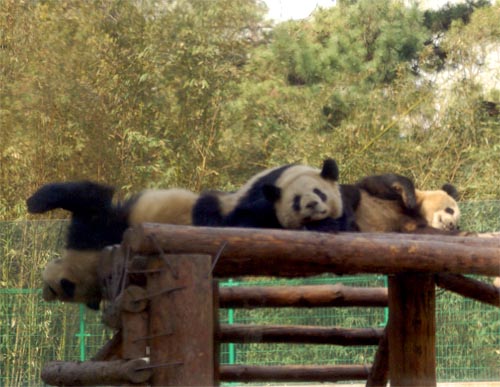
Napping Pandas
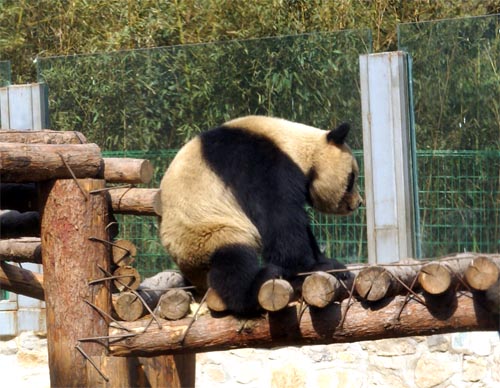
Back-scratching Panda
Other than the large collection of pandas, there was pretty much the standard collection of animals you'd expect to see in any regular zoo.
After the zoo we got ready for the train trip to Shanghai. Our tickets were on the "Z" train, which is a new express line with fancy "soft" sleeping berths (the alternatives were "hard sleepers," which didn't sound too fun). The express trips are 11 hours rather than the typical 20. The tickets were about 500 RMB ($75) each, depending on whether you got the top bunk or the bottom. The bottom bunk is considered to be better since it's easier to get in and out of, and it's cooler since the hot air flows to the top of the room (along with the cigarette smoke, as we discovered).
The train station was pretty crowded and was fairly confusing since none of the signs were in English. Our tickets were in Chinese and had 4 numbers on them. I knew that they were probably the train #, platform #, car # and seat #, but I couldn't be sure which was which. Fortunately there was an information booth which was able to point us in the right direction.
On the train we had an enclosed room with 4 bunks:
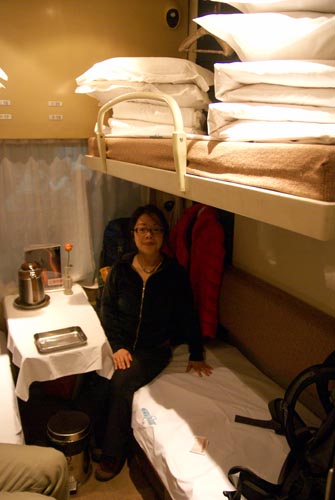
We shared the room with another man and woman. They were friendly, though we weren't able to communicate with them beyond simple gestures. In the room it was pretty tight, so many people sat outside in the hallway, where there were fold-down chairs:
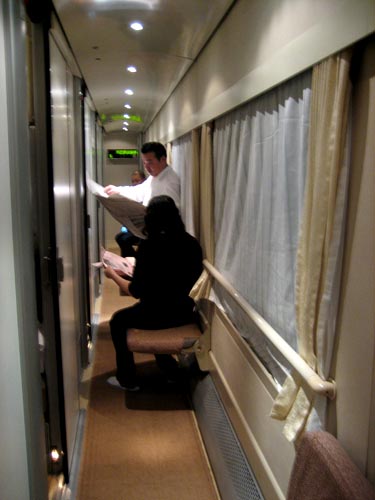
This was the bathroom:
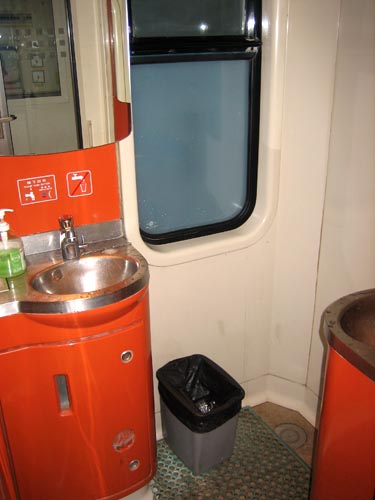
You don't see the toilet, because it was basically just a hole in the floor, just off camera.
Unfortunately the train left after dark, so there wasn't much that could be seen outside. I was interested to see the Chinese countryside between Beijing and Shanghai, but I wasn't really able to - I slept well enough that I woke up without much time to spare before the train arrived at 7:30 AM the next morning.
Beijing Day 3
This is part 3 in a series - for the first two parts, see Beijing Day 1 and Beijing Day 2
On the third day in Beijing we went to see the Great Wall of China. Our Lonely Planet guidebook didn't have too many details about the best way to go to the wall, so we followed its suggestion to catch a bus near Tiananmen Square. In retrospect we should have done more research beforehand (more on that later).
We found a bus depot labeled "Beijing Hub of Tour Dispatch," which looked official enough. It was hard to know whether the company was run by the government or was just a private firm, but I think we would have had that problem even if we had been able to read Chinese. In China it is difficult to tell where the government ends and where private enterprise begins. In the goold ol' communist days, the state was omnipresent and ran everything. As China has opened up, that grip has loosened and private companies have sprouted up all over the place. However, many 'independent' companies are still owned and/or controlled by the central government anyway, so it can be somewhat deceiving. It turned out that this bus tour company was actually run by the government, but we weren't able to determine this until we looked it up online later.
We bought the most expensive tour ticket, which was the "Great Wall + Lunch + Ming Tombs" ticket, for 150 RMB (~$20). We were shortly herded onto the next bus with a bunch of other tourists. All of the other tourists were Chinese citizens - we were the only Westerners on the tour, which was completely in Mandarin (that probably should have set off some alarm bells, but it didn't at the time).
A side note on tourism in China - while we were there (late March), most of the attractions we visited were very crowded with tourists. The surprising part was that the vast majority of the other tourists were Chinese people, presumably visiting from the many other parts of China. I expected to see a lot of Americans and other foreign tourists, but they were actually quite rare. In retrospect it makes sense - China has 1.3 billion people, many of which probably want to visit Beijing, much like American tourists flock to Washington D.C. or Hawaii.
Anyway, the bus tour started and turned out to be a tour of Beijing for the first little while. There was a tour guide at the front of the bus pointing out landmark buildings and explaining all kinds of interesting things (we presumed) in Mandarin. We didn't understand any of it, and had to hope that we weren't missing anything important. Here's a picture of what it looked like from our perspective:
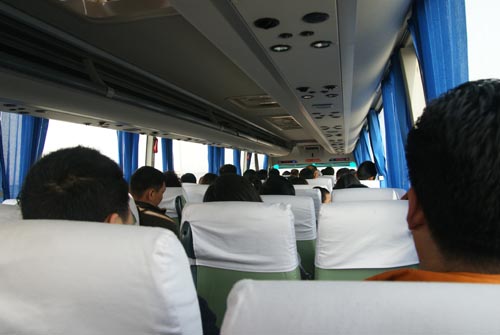
Eventually the bus stopped off somewhere and we all got off. I thought we were at the Great Wall, but we learned several minutes later that we were actually at the Ming Tombs, which are naturally the tombs of the Ming dynasty emperors. Apparently they are situated along the way to the Wall, so it is common to stop by and see them as well. They were in a hilly wooded area, which provided a nice break from the city:
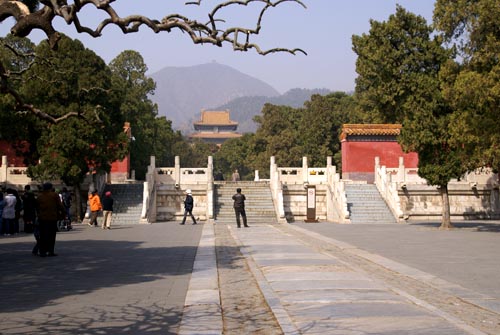
The main attraction was the underground tombs, which turned out to be a somewhat-disappointing large room with some coffins:

If we had been students of Chinese cultural history, it may actually have been quite interesting. For us, though, it probably wasn't quite worth the time taken away from visiting the Great Wall. We waited around for an hour and a half before getting back on the bus, which we almost missed due to a miscommunication about where to meet up and the fact that my watch was about 5 minutes different than the tour guide's watch.
After the tombs the bus drove us to a sort of shady-looking industrial area where we got dropped off for the "free lunch." The lunch turned out to be a forced tour through a jade museum/shop. We were told (as far as we could tell) all about how jade is a valuable, precious mineral that conveys good luck and status to its owner. Apparently there are a lot of people selling fake jade, so you should only buy the expensive authentic jade, which, as it turned out, they had a whole bunch of right there, and lots of saleswomen to sell it to you. The lunch consisted of steamed rice buns and some sort of meat. All in all it wasn't very filling, but if you wanted more food you could buy it at the overpriced shops conveniently right next door.
Eventually we finally made it back onto the bus and started off for the Great Wall at around 2:30 PM. The bus drove for a while dropped us off at the bottom of a valley below the Great Wall. I thought we'd be able to just walk up to it, but that wasn't the case. Our tour guide talked to us for a couple of minutes and then herded us into a line to buy 70 RMB tickets for a little train ride up the hill to the wall (for some reason we didn't remember reading anything about having to buy another ticket once we actually got to the wall). We had no idea what the tour guide had actually said, so we just got in line along with everybody else - it's possible that she had explained that it was possible to walk around a different way and climb up to the wall without needing to buy a train ticket, a fact we realized only after we got to the top.
Next we went to go stand in line for the train. The line looked pretty short, until we got around the first corner and noticed that it was actually quite long. We didn't think that we had any other options, so we just waited in the line, which moved incredibly slowly. After about an hour and a half, we finally got up to the ride to the top. The ride was quite a rickety contraption - it certainly didn't look like it would meet the safety standards of any first-world country. We didn't get a good picture of it, but you can sort of get the idea from these shots:
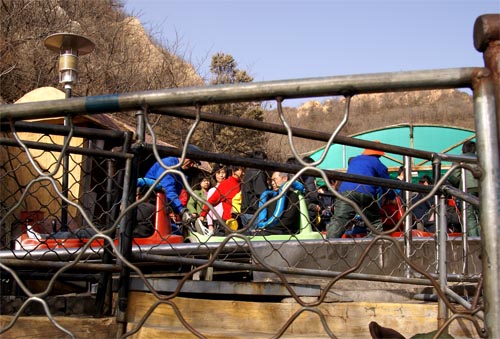

When we finally got to the top we were able to actually go onto the Great Wall. At this point we were able to see that the "real" entrance to the Wall was on the other side of the hill. That entrance had a large parking lot, bus depot, and only a slight hike to the top. Our tour had dropped us off on the back side of the hill, probably as part of some sort of arrangement with the people running the train ride. We also now had about 30 minutes left out of our "2 hours" at the wall, and we still had to get back down to the bus.
Our dropoff spot along the wall was actually a pretty good viewing point, and the wall itself was an impressive sight (though perhaps a bit less so if you were aware of the fact that the original, historical Great Wall has long since completely collapsed or been eroded away, and the current wall has been reconstructed for tourists and only runs for a couple of miles).

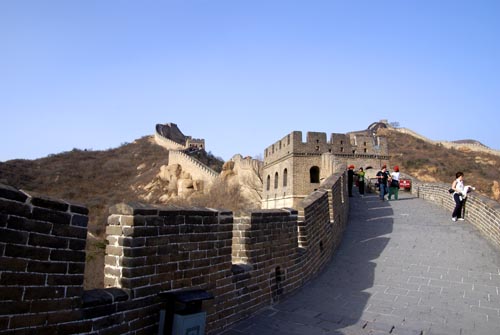
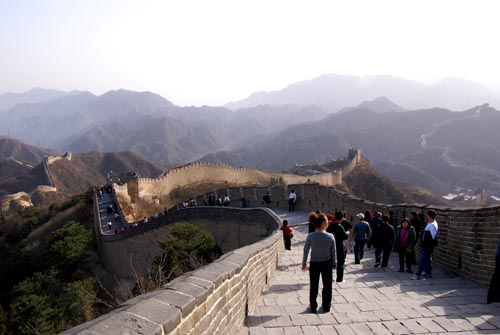
Apparently if you hike down along the wall a little way you can get away from the tourists and have a great view all to yourself. Unfortunately in our case, we only had enough time to snap a few pics before heading back to ride back down to the bus. While on the wall we found and asked a couple of Americans how they had gotten there. They said that their tour group had rented a private bus that drove to the main entrance, and that they had been there for 6 hours ("so far"). In retrospect, we clearly should have done something more like that. C'est la vie..
Anyway, the trip back to the city was fairly uneventful, though we were lucky enough to experience the joys of Beijing rush-hour traffic while trying to get back to Tiananmen Square. We were curious how the other people on our trip felt about getting ripped off, but we didn't really know how to ask them. There didn't seem to be much anger or displeasure, and certainly nobody was screaming and demanding their money back, as surely would have happened in the U.S.
Later our Chinese friend told us that we shouldn't have felt too bad about the whole thing since whole busloads of local people also went along with it - clearly we weren't suckered in because we didn't know Chinese. We also learned that we should have been tipped off by the cheap price (20 USD for a day's tour) - anything so cheap is almost guaranteed to have lots of stop offs at jade shops or herbal medicine clinics. Apparently the government set up this particular company in order to clean up the tour business, which was actually even worse beforehand.
Later that evening our friend took us to a 5-star restaurant which is apparently famous for its Peking Duck. He ordered a bunch of food for us in Chinese, so we had only a vague idea of what we were getting. Here are a couple of the appetizer dishes:

The one on the left was supposedly some sort of "pork dish." After I had a piece, it was revealed that it was actually pork hoof, which explained why it was sort of chewy.
After a while the Peking Duck arrived, roasted on a platter. Unfortunately we didn't get any pictures of it until it had already been chopped up into nice little pieces:
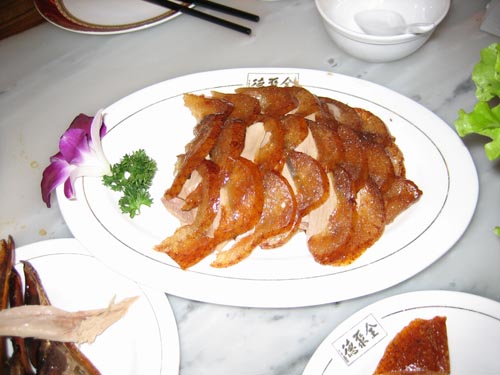
Overall it tasted pretty good. The duck even came with an ID card, which listed the duck's number and history up until the day it was killed and roasted. The meal also included the head of the duck, chopped in half:
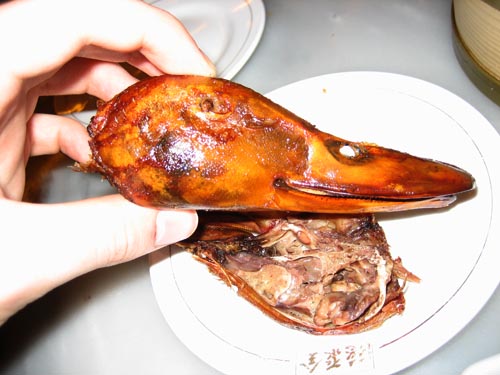
Apparently the brain of the duck is some sort of delicacy. Alas, I wasn't quite brave enough to find out how it tasted.
Beijing Day 2
This is the second post in a series - for the first, see Beijing Day 1.
On the second day in Beijing we went to the Summer Palace, a former imperial palace in the hills on the edge of the city. It was used as a retreat from the crowds and heat (both for the imperial court as well as modern-day tourists). The main attractions are a hill overlooking a large lake - the former apparently built out of the land excavated while digging the latter (requiring the work of 100,000 laborers).
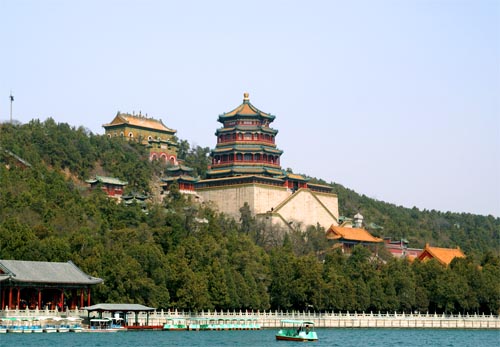
The buildings and a large Buddhist temple overlook the lake.

The view from the top of the temple shows the lake, whose causeways and islands were patterned off the West Lake in Hangzhou (about which there will be more in an upcoming post on Shanghai).
As with the Forbidden City, much of the original architecture and artifacts have been destroyed - this time during the Opium Wars by British and French troops. After the wars, the Empress Dowager Cixi rebuilt much of the Summer Palace to her own liking, including this large marble boat:
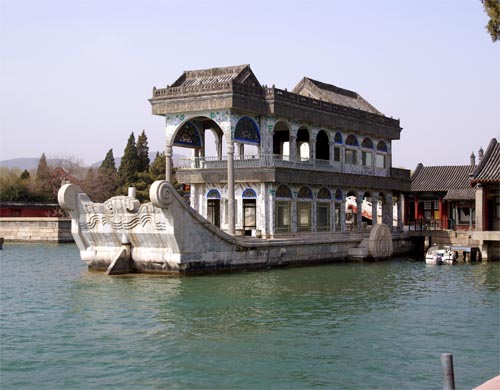
Along with other things, it was built using funds meant to be used to rebuild the Chinese armed forces. Not surprisingly, what remained of her empire was overrun by the revolution of 1911 only a few years later.
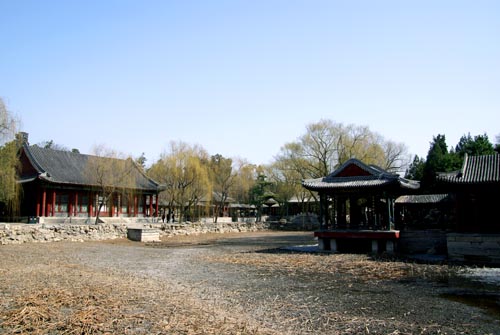
This garden would likely have been much more impressive with water in it.

A large Buddha statue, with a "No Pictures" sign.
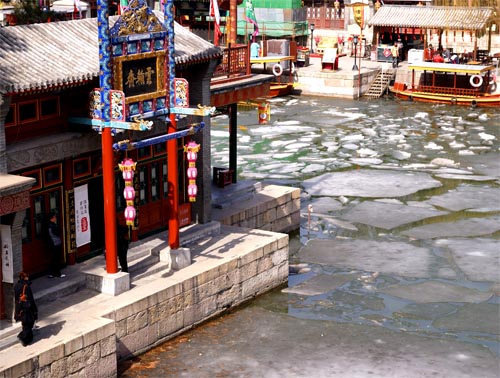
Behind the hill there was a river with a small "town," which turned out to be a trap - once inside, you could not get out until you walked along the whole thing, past lots of little shops hawking various things.

Apparently breaking the ice is a manual process, requiring one guy to do the work and two to watch.
After the Summer Palace we decided to explore around town by foot for a bit. This turned out to be a more interesting experience than I had expected. It quickly became apparent that pedestrians do not have the right of way anywhere near the streets - in fact, the "right of way" is a somewhat nebulous concept in China. If a car is coming, it's not going to stop, so you had better get out of the way. There are occasionally "walk" signals at intersections, but these seem to be mere suggestions. It took me a while to get up the nerve to cross large streets until I realized that I would just need to accept a higher level of risk of bodily harm than I am accustomed to. Once you get past that, it feels sort of like playing a video game (like Frogger), except if you lose a life, it is your own.
Unfortunately we didn't stop to take many pictures that really captured the experience, but it was very much like the famous "Driving in India" YouTube video that made the rounds a couple years ago (an interesting one to watch if you haven't seen it). Here are a couple pictures we did manage to take:

Still pictures don't really capture how cars were just going in all directions at all times.

Scenes like this were common - people would carry what appeared to be entire apartments' worth of furniture on their bikes, sometimes with assist motors but just as often without.
Once in a car, things felt a little safer, but not by a whole lot. About the only traffic rules which really seemed to be followed were: drive on the correct side of the road, stop if a stoplight has been red for a while, and mostly try to stay within the marked lanes, although these rules were pretty flexible. Turn signals are not used - if you want to change lanes, you just go for it and stick your hood in, trusting that you will not be hit by the car formerly occupying that space. Riding in a Taxi was often a harrowing experience, only abated by the fact that most of the time you were traveling fairly slowly due to the terrible traffic. There were no seatbelts in the back of the taxis. Once I became quite worried when it looked like the driver had actually decided to put on his seatbelt while flying down a highway at high speed, but he was actually only just reaching to answer his mobile phone.
Taxis are very cheap - they cost 10 RMB plus 2 RMB per km traveled, meaning that you can travel halfway across the city for only a couple of USD. We ended up taking taxis everywhere we went in Beijing since they were so cheap, fast and direct. There weren't many other good options (the subway system is still mostly under construction, and it was impossible to decipher the Chinese schedules for the buses, which were overcrowded anyway). Apparently many tourists find it cheap enough to actually hire a private car and driver while in Beijing. We didn't do that because the taxis worked fine as long as we had a written Chinese version of the address where we were going. We never really encountered any problems with the taxi drivers. Apparently if any complaints are made against the drivers, they will be fined a couple months' worth of salary, which keeps them in line (a friend also told us a rumor that the communist government recently executed some drivers for scamming tourists, but The Google wasn't able to confirm that one). Still, there were a couple of times when we would ride somewhere for 20 RMB, and the return trip would cost us 11 RMB (so clearly at least one driver had "accidentally" gone the completely wrong way), but we never bothered to make a fuss.
That about wrapped up Day 2 in Beijing, though we also stopped by MSR China:
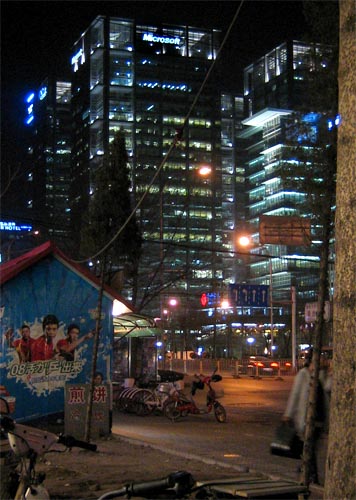
It's not visible in the picture, but immediately behind the Microsoft building is a giant Google building.
Beijing Day 1
Here's the first part in a series of more detailed write-ups of my trip to China and Japan. The first city we stopped in was Beijing.
Our flight left Seattle around 2 PM on Friday and had one stop-over in Tokyo for a total flying time was about 15 hours. I was a bit worried about flying with Northwest Airlines because of their terrible reputation (worse than Comcast and Exxon, is that even possible?), but everything actually went pretty well. The flight was an hour late into Tokyo, but they held the flight to Beijing until everyone was aboard. We had to go through another security check in Tokyo before re-boarding, and I had to quickly chug a 1 liter water bottle which I had foolishly refilled after the previous checkpoint.
We arrived in Beijing around midnight local time, so it was difficult to see much. The first thing I noticed was how immensely huge Beijing Capital Airport is - it was expanded for the Olympics to be the largest airport in the world (size-wise). The tarmac went on and on for what appeared to be miles. I don't know how many people's homes were destroyed to make room, but it was probably quite a large number.
At the airport we bought a China Mobile simcard to get a local Chinese phone number and caught a cab without too much problem. We stayed in Haidian (the university district), nearby the competing Microsoft Research and Google offices, approximately here: map link. Unfortunately we had the wrong address, but we eventually found the right place after calling our local contact and having him talk to the cab driver. The total cab ride was about 30 km and cost about Y35, or around $5.
I was traveling with my friend Angela from work and we stayed at the apartment of one of her friends, who is running a software startup in Beijing. He wasn't in town while we were there, so we were able to use his room. Fortunately his Chinese-speaking roommate was around and was able to help us out. They live in a small apartment in a building which appeared to be some sort of student housing, run by the government (as far as I could tell from reading the signs on the doors).
Unfortunately we didn't get any pictures of the apartment, but I wish we had. The doors were particularly interesting - there was an outer security door which opened into a hallway for two apartments. The inner door used locking and latching mechanisms unlike any I have seen before. It used a 4-sided key (shaped like a plus symbol) and appeared to be descended from Soviet designs. The inside of the apartment had three bedrooms (one used as an office), and a tiny kitchen and tiny bathroom off the main room. The bathroom was European-style with no separate shower or tub region - instead there was a drain in the middle and you had to avoid splashing water all over the toilet, mirror and sink. Fortunately the bathroom did have plumbing and a sit-down toilet (unlike most public and/or older restrooms in China, which use "squat" style hole-in-the-ground toilets).
As soon as we arrived we went to sleep since we had been awake for about 20 hours. Fortunately during the entire trip I never had too much trouble with jetlag and I was able to sleep pretty well (possibly due to the careful use of some Tylenol PM sleeping pills :)).
The next morning we woke up and took a cab ride to Tiananmen Square. During the cab ride we got our first glimpses of the city during the day, although it was difficult to see much of anything farther than 10-15 blocks because of the pollution. Without the pollution I'm sure Beijing would have looked much larger and grander.
Tiananmen Square was about what you'd expect - a large open square in front of the Forbidden City. There were a few buildings like the Mao mausoleum, but they were closed for renovations. One surprise was that there was a security check in order to get onto the square, with a bag-scanner and metal detector. The employees didn't seem to be too serious about their job, though - the metal detector buzzed when I went through it, but nobody checked me (there were two girls with wands, but they were talking to each other off to the side). At one point there wasn't even anybody manning the bag scanner at all. This seemed to be typical of security checks throughout China - they clearly did not care about someone who was obviously a tourist, but anyone who looked like a poor, local Chinese person seemed to get checked more rigorously.
Here are a few pictures from Tiananmen Square:
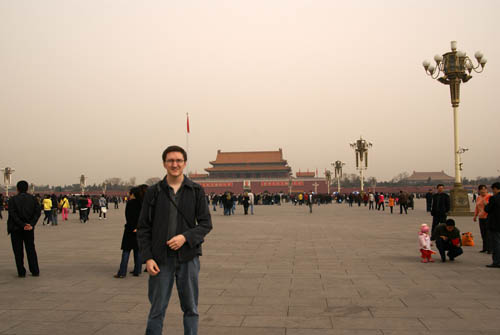
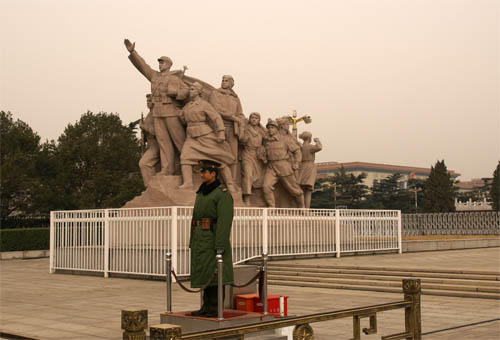
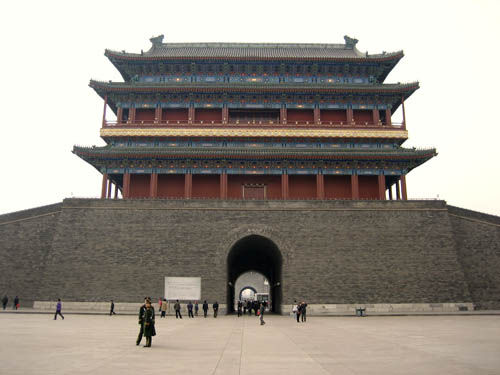
North of Tiananmen Square is the Forbidden City, the former palace of the Ming and Qing dynasties. It was most impressive for its sheer size, which can sort of be glimpsed in this picture of a model:

Several times we walked across a large courtyard thinking we had seen the main buildings, only to find an even larger courtyard and set of buildings on the other side. The largest building in the center is the Hall of Supreme Harmony, which is where the Emperor lived:
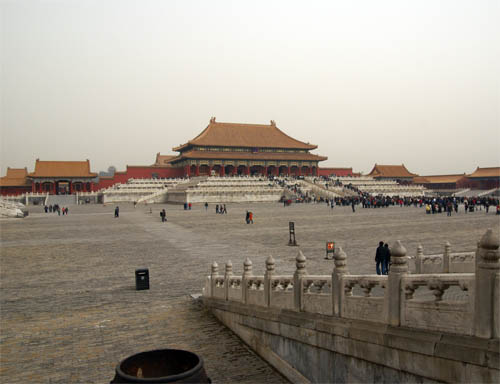
As you can see from the picture there was an immense crowd streaming up to the entrance of the building, where you could take pictures of the imperial throne. We didn't feel like pushing and shoving our way through the throngs of people, so this was the best picture we were able to get (the contrast for the indoor section has been adjusted):
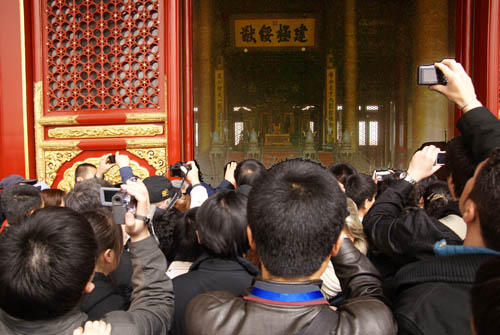
Our Lonely Planet guidebook (from 2007) claimed that there was a Starbucks inside the Forbidden City, so we searched high and low but were unable to find it. Apparently in the run-up to the Olympics, the government decided to kick Starbucks out and replace it with a "China Coffee" stand.
Aside from the architecture, there was unfortunately not a whole lot else to see in the Forbidden City. The majority of the imperial collection was destroyed, looted, or shipped off to Taiwan during the Chinese civil war. That said, we were still able to find a few interesting things to snap pictures of:

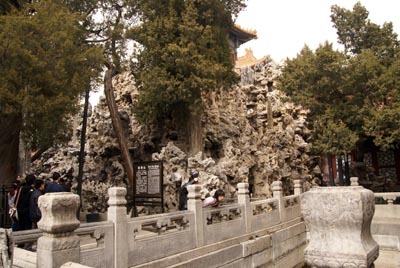
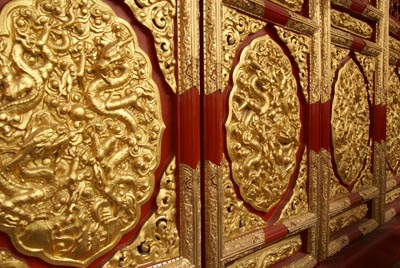
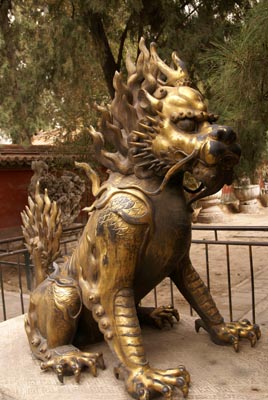
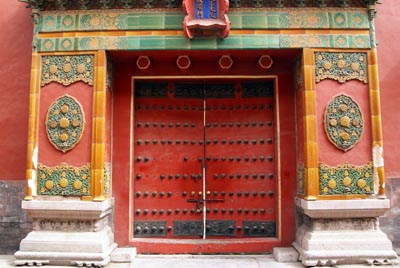
Once we were satisfied that we had seen everything, we wandered over to see a "night market" that the guidebook raved about. There were still a few hours before night, so we checked out a nearby shopping mall. It had a lot of expensive Western and Japanese stores in it, so it must have been mainly for tourists or rich people:

Strangely enough, there was an "Ireland Culture Festival" happening at the mall that day, complete with harp performances and jig dancing. It was apparently put on by the Irish embassy:

Once it got dark, the Wangfujing Night Market opened up. It's famous for having all kinds of crazy foods, like scorpions and starfish:

Octopus on a stick, anyone?
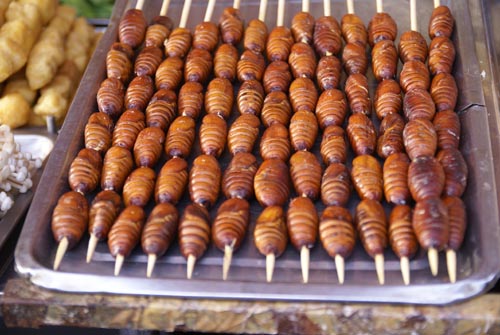
Or bugs on a stick
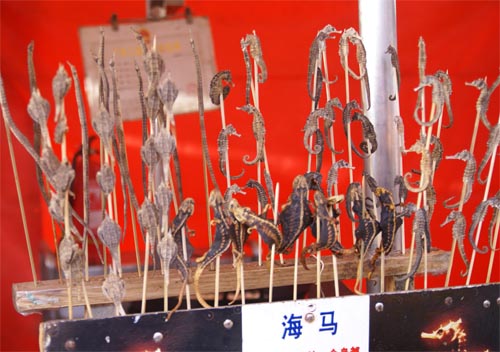
Seahorses on a stick

I'm not even sure what these things on the left are, but they're on sticks
I didn't eat anything much crazier than something described as "fish balls." The most surprising thing about the night market was how extremely organized it was. Each vendor had a clean, organized stall, and everyone was wearing the same uniform. Our friend later told us that the Chinese government heavily regulates this particular market and forces it to be extremely clean and organized since it is a large tourist attraction. He even described it as "un-China-like" because a regular street market (for the locals) would be much different.
That about wraps up Day 1 in Beijing - I'll post Day 2 next.
China & Japan
Update: I've written up more detailed posts about the trip: Beijing Day 1, 2, 3, 4-5, Shanghai, and Tokyo.
I haven't posted for a few weeks because I've been on a trip to China and Japan. I got back today but I'm still on Tokyo time and pretty tired and jetlagged. I'll write up some much more detailed posts later, but in the meantime here are a few pretty pictures to look at:

The omnipresent portrait of Mao
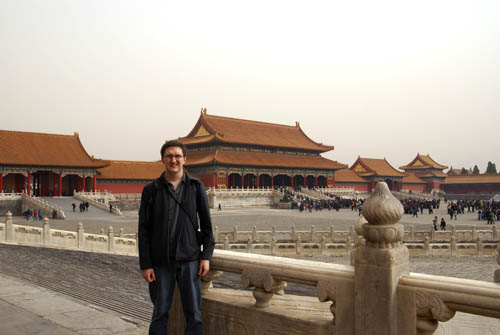
The Forbidden City is no longer forbidden under the communists. I wish I could say that this is just a bad picture, but it really looked this bad (or worse) around Beijing due to the pollution.

The "bird's nest" Olympic stadium - again the pollution is so bad that you can see it even in the stadium.
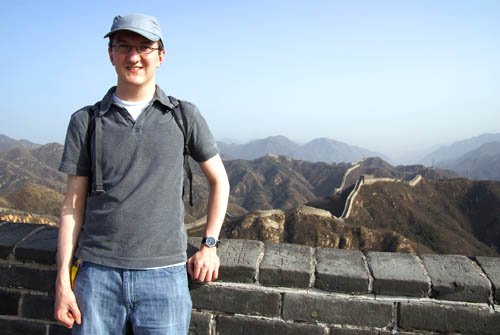
The Great Wall of China is up in the hills, so it's a little bit clearer.

One morning in Shanghai was actually very clear and we were able to snap this nice pic of the modern skyline.

The buildings on the opposite side of the river are all left over from British colonialism, which creates a strange juxtaposition.

In Tokyo the Imperial Palace is still off-limits, but you can sort of peek in.
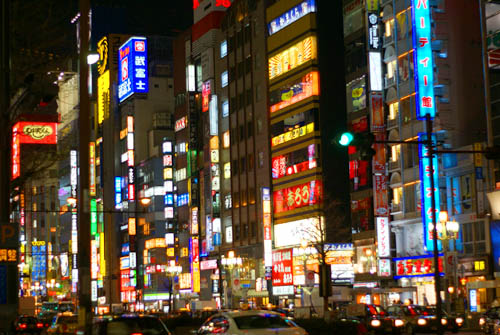
Nighttime in Tokyo is a sea of neon light.

Japanese toilets take a little getting used to. This one in our hotel was a simple model that only had two water jets and a pressure control (no aim control, heated seats or blow-dryer).

Netbooks in Japan are even smaller and crazier than in the US - this one has a touch screen, swivels into a Tablet PC, has an antenna for watching TV, a GPS, and a dual-core processor.
Trip Report
I got back from my trip last Sunday night, but was too busy catching up on various things to write up a post about it until now.
Overall the trip was totally awesome! Except for a tropical storm at the beginning, the September weather was perfect for almost the entire time. I was able to see everything on my (long) list and even more. In fact, two weeks might even have been a bit too long: on the second-to-last day I realized that I had pretty much seen all the big-ticket sights, as all I had left to see that day were the semi-abandoned grounds of the 1964 World's Fair and under-demolition Shea Stadium (both somewhat underwhelming).
I had originally only planned to scope out a few of the top software companies, like Google and Fog Creek, but some unexpected turns of events left me with a lot of free time to explore others as well. I was somewhat surprised at the sheer number of cool software jobs and startup companies which were located in NYC. Google's offices in Chelsea were particularly awesome (er well, the building and location are awesome, but the 'offices' are actually more like cubicles and 'open workspaces' - I'm not sure what I think about those yet..). Of course, while I was there, the entire financial industry sort of imploded on itself, which will undoubtedly lead to a glut of thousands of out-of-work bank IT workers, pushing down programmer salaries there for some time. Million-dollar Wall Street bonuses probably won't be making appearances again for a while either..
I was able to get out of the city for a day and got a tour of Princeton, NJ from my friend Savraj who lives there working on his Y Combinator startup. The startup life sounded pretty cool. I was also considering going to Boston for a day (lots of interesting companies & opportunities there as well), but decided not to when I found out that it would have and cost 4 hours and $100 each way on Amtrak.
Due to the outrageous ticket prices, I only saw one Broadway show while I was there: The Lion King. I wasn't quite sure what to expect going in. Now that I've seen it, I suppose that if your goal was to make a Broadway musical out of that Disney movie, they did a good job. It was well staged, choreographed, and acted. But it also re-used most of the dialog from the movie, as well as the fart jokes (which, in the commentary, the directors of the movie admit were inserted in order to keep 6 year-olds from becoming bored), leading to many awkward, incongruous moments. It felt like nobody had ever stopped to ask "Wait, why are we making a musical out of this??" (In reality I'm sure that question was asked at some point, and the answer was "Because it will make millions of dollars!").
I'm sure that everybody has seen the internet-famous map of the distribution of single people in the US. It pointedly shows that the Seattle area has 40,000 more single men than women, but the NYC area has about 200,000 more single women than men. The dearth of attractive, single women in Seattle has certainly been stunning, so I was curious about whether the opposite effect would be noticeable in New York. It was quite noticeable - surprisingly so, even. There seemed to be beautiful women everywhere - on the street, in shops, on the subway, etc.. I'm trying to do the math to figure out whether this could have just been an anomaly (due to NY Fashion Week coinciding with my trip, or something like that). I'll run the numbers from the National Geographic article to calculate the "expected odds" and post the results up soon. Either way it was quite impressive.
Another particularly striking thing for me was the efficiency of the public transportation system. I had no car but didn't feel like I needed one at any point, since I could easily get to basically anywhere in the city using the subway. It really puts to shame the public transportation systems in cities like Denver or Seattle, which basically consist of "some buses". Building a real subway system in these sort of cities today would require absolutely astronomical amounts of money, so it's probably hopeless at this point.
During the second week I didn't bring my camera around as much unfortunately, but some of the pics I did take are below (the first week's pics are in the previous posts).
I took a whole lot of pictures from the top of the Empire State Building, figuring that I could find some software to stitch them all together into a panorama automatically. Interestingly enough, while I was there Microsoft Research released a free tool which does exactly that. It works pretty well, though it did screw up a few places like the Brooklyn Bridge. Here's a thumbnail of the panorama, linked to a larger version:
The larger version is still only 15% of the full-resolution image which is 16,000 pixels wide at 150 MB, way too big to upload here :).
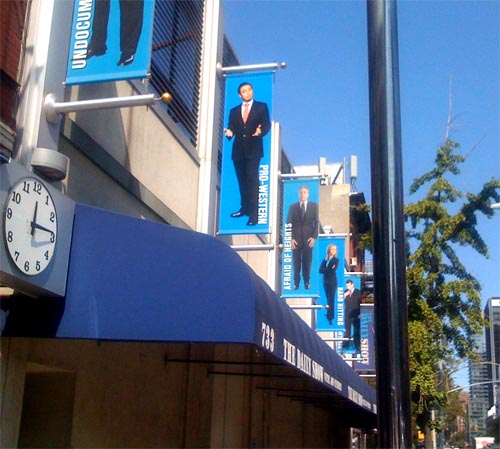
I tried to attend a taping of the Daily Show, but I didn't realize that all the reserved tickets are gone months in advance, and the standby line was ridiculously long, even several hours before the taping (apparently the guest that night was some guy named Tony Blair). When I realized that I wasn't going to get in, I ran over to the Colbert Report studios, but by that time it was too late there as well.
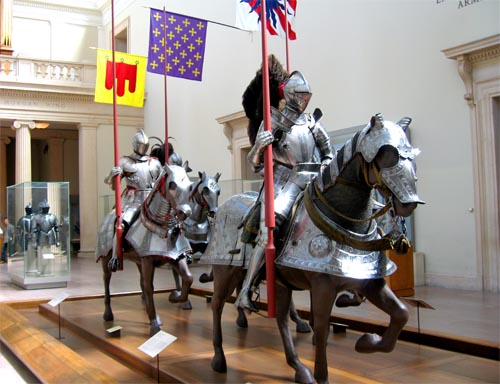
Arms and Armor at the Metropolitan Museum of Art.
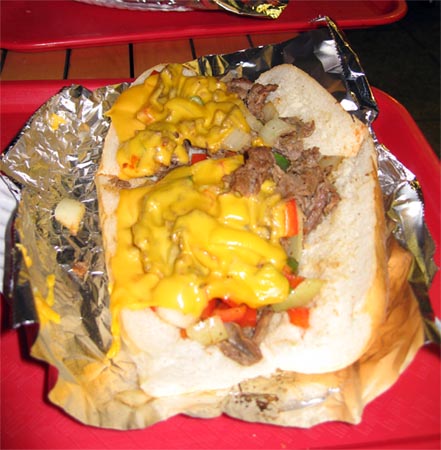
A cheese steak sandwich, which was quite good, but presumably also quite unhealthy.

Lions and gazelles at the Bronx Zoo.

The Unisphere from the 1964 New York World's Fair.

On the flight back all of the in-seat video consoles simultaneously crashed and rebooted during some turbulence (always a good sign..). I was only able to get a cameraphone pic of Tux before it was back up again.
Week 1 Update
No time for a full recap yet, so here are some pretty pictures to look at:
Rockefeller Center, NBC Studios
Vincent Van Gogh - Olive Tree
John Lennon memorial - Imagine
UN General Assembly hall
Apple 5th Avenue store (craziest Apple store ever)
WTC Ground Zero (on September 12th)
Statue of Liberty
Cars on the Brooklyn Bridge at night
Astroland amusement park at Coney Island (one week after it went bankrupt and closed, naturally)
NYSE on Wall Street (on Monday it was a total zoo due to the Lehman Bros/AIG/Merrill Lynch disaster)
New York City
So after thinking about it for a long time, I finally got around to going to New York City!
I got here on Saturday, and so far it's been awesome! (other than getting rained on by Tropical Storm Hanna)
I'm here for two weeks, which should be plenty of time to see all of the big-ticket attractions and some of the smaller ones too.
I'll write up a more detailed trip report when I get back, but for now here are some pretty pictures:

View from the Empire State Building, with Central Park visible in the background.
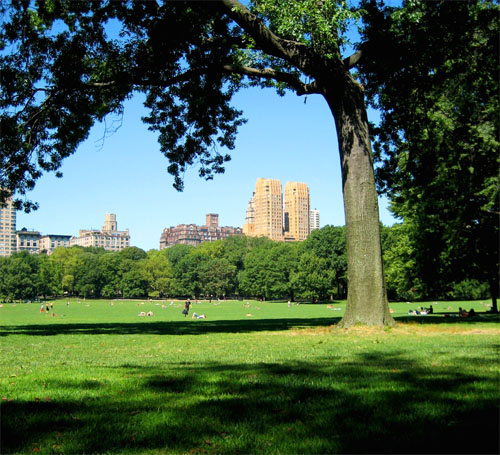
The view from Central Park.
Willows Lodge
This week I'm on another corporate brainwashing training retreat at Willows Lodge. So far the accommodations are a lot better than last year since we get catered food at a 5-star resort hotel instead of having to fight over cots and cook our own food.
Pics:

Jacuzzi, bed, fireplace (this pic looks it's out of a brochure for some reason..)

Fold-out concave shaving mirror

Fancy sink

Shower with on/off buttons and temperature controls. What temperature water do I usually use? I had no idea until now

Some bizarre statues outside the window
Retreat Pics
Here's some pics of the Leavenworth retreat. I might write up a more detailed description later if I fail to get a Wii tonight 🙂

There was a lot of snow on the bus ride up

The lodge

Unpacking

You got a cot if you failed in the scramble for beds

The power went off for the first night, which was lots of fun, especially when we discovered that the toilets and showers were on a water pump, which was also off

No Fishin'

Rope traversal across a "chasm" of wet horse poo

Getting lost on the compass & map activity (I'm in the back)

Class activities

On the bus ride back we learned a bit of Mandarin Chinese. When we learned numbers there was an argument about whether we should learn 1-10 or 0-9. Can you tell we are programmers? 😉
Silicon Valley drive-by shootings

Intel

Sun Microsystems

nVIDIA

Apple

Google (Building 3.1415926...)

HP

IBM
I also saw Yahoo! and Adobe, but I didn't get my camera out in time.
Redwood pictures
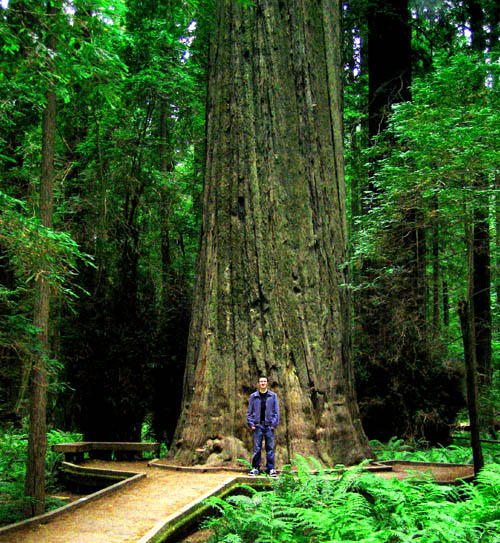
Me standing next to a medium-sized tree

This fallen tree was as big as a train wreck

This stump was two stories tall
Diablo elevator
I wasn't sure what to make of this elevator sign in my hotel today:

Going down?
Northern California
Live in Northern California once, but leave before it makes you soft.

Vineyards everywhere

Flowers by the side of the road
Vacation
This week I'm on vacation in California. Here's a picture of me at the Golden Gate Bridge:







